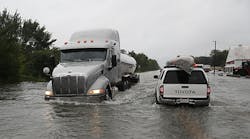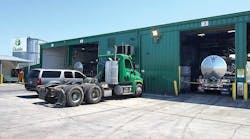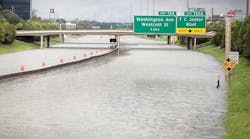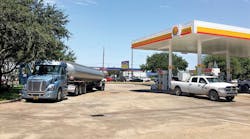Latest from Trends
IHS Markit offers latest assessment on supply chain recovery from Hurricanes Harvey and Irma
IHS Markit, a world leader in critical information, analytics and solutions, has released a new report on the impact of Hurricanes Harvey and Irma on the national and regional economies, transportation infrastructure, automotive industry and the crude oil, refining, and chemical sectors.
Regarding the overall US economic impact: “We currently estimate that the damage from Hurricane Harvey will total somewhere between $60 billion to $100 billion in 2017 dollars, making it the second most destructive storm on record after Katrina, and Irma, at $30 billion, will rank sixth,” said Patrick Newport, executive director, US economics for IHS Markit. "We estimate that the hit to third-quarter GDP growth from these two storms will be about 1.2%: -0.5% from Harvey and -0.7% from Irma.”
• Hurricanes Harvey and Irma have disrupted economic activity in the third quarter, but recovery and rebuilding will boost growth in subsequent quarters.
• The extent of the reduction in GDP growth during the third and fourth quarters and the subsequent rebound during the first half of 2018 will depend on the extent of damage to key segments of the impacted economies and how quickly the reconstruction efforts can get under way.
• Personal income will take a direct hit from Hurricane Harvey and Irma due to the lost wages of displaced workers, as will real spending growth. Real residential investment growth is expected to turn positive in the third quarter.
• The hurricanes are not expected to alter the course of the Federal Reserve; IHS Markit expects they will proceed with a rate hike of 25 basis points in December.
Impact on the energy industry:
“Compared to prior storms, the increased global connectedness of the US energy industry caused Harvey and Irma to have a greater impact on markets outside of the United States,” said Kurt Barrow, executive director, oil markets, midstream and downstream for IHS Markit. “The energy abundance created by tight oil and shale gas means the United States is now a major exporter of crude, refined products, and NGLs (natural gas liquids) and increasingly LNG (liquefied natural gas) and petrochemicals. As a result, importers of US energy were also affected by these US hurricanes as never before.”
• Global crude oil markets were relatively undisturbed by the hurricanes as production shut-ins were more than offset by the decline in refinery demand. High crude oil inventories and uncertainty of offtake initiated inland US crude oil price discounts relative to Brent while coastal crude oil grades, like LLS, mostly remained in-step with the international benchmark Brent.
• Within a matter of days, one-quarter of the US refining system was offline as three major Gulf Coast refining centers shuttered. After the storm passed, it took several weeks for these plants to return to full capacity due to the inherent complexity of these refineries and some logistics issues with crude oil supply, product offtake, or utilities supplies caused by the flooding.
• The impact of Harvey and Irma on gasoline prices was similar to prior storms Katrina, Rita, and Ike in magnitude and duration. Retail prices across the United States were affected as refinery supplies shut down and offshore imports took time to arrive. Imports of gasoline from Europe increased rapidly but prices on both the East and West coasts increased by over 20 cents per gallon relative to crude oil price, those prices then began to decline. Directly impacted markets like Atlanta GA and Miami FL saw higher prices that lasted longer due to the impacted supply chains in these markets.
Impact on Texas and Florida economies:
“Harvey and Irma have posed significant short-term challenges but they will not change the favorable long-term growth trends for Houston or Florida,” said Karl Kuykendall, principal economist, US regional economics for IHS Markit.
• Houston’s role as an energy and trade hub provided a strong urgency to get the city back on its feet. There were massive disruptions in Harvey’s aftermath but the main levers of Houston’s economy are largely up and running again.
• Florida avoided a worst-case scenario with Irma but the evacuations leading up to the storm, widespread power outages in the aftermath, losses in the agriculture industry, and a temporary hit to tourism will cut into Florida’s near-term growth.
• The most long-lasting effect of the storms will fall on homeowners who sustained damage and the construction industry. The bulk of the rebuild should take place within the next 12 to 24 months but the pace will depend on how quickly relief and insurance monies are distributed and the availability of labor.
Impact on transportation infrastructure:
“The difference in cooperation between all parties this time versus earlier storms such as Katrina was very dramatic; most everyone was as prepared as possible and relief efforts were well coordinated,” said Charles Clowdis, director, industry consulting for IHS Markit. “Federal, state, local authorities, volunteers, and other groups learned from the lessons of Katrina and were better prepared despite the uncertainty of both storms and the lingering rain from Harvey.”
• Transportation infrastructure has been restored almost entirely with some delay on local streets in Houston due to the Addicks dam release. Railroads have resumed operations, with some of them having slower train speeds in the Houston area. Ports have mostly resumed operations, with some slower operations in Houston due to closed refineries. Airports have resumed operations in all impacted areas.
• Transportation volumes stalled by the hurricanes have started to come back. Transportation rate spikes have also begun to stabilize, but are still higher than they were before storms hit. Tightening in freight capacity, even before the hurricanes hit, will have an effect on increased transportation costs in the third and fourth quarters of 2017. Demand for flatbed and specialized trucks will increase.
Impact on chemical industry:
Chemical producers continue to improve resiliency to hurricane events, with risk assessments leading to reinforced structural systems and added redundancy for critical piping and control systems, implementation of precautionary actions regarding asset operations, and pre-positioned inventories.
“In the next decade the United States will build 25% of the world’s needed capacity for new chemicals demand. US chemical exports will double from 2005 levels, linking the global chemical markets integrally to events that affect the US Gulf Coast,” said Dewey Johnson, executive director, chemicals for IHS Markit.
• The chemicals supply chain consists of long multi-step chains and combined product chains of precision formulated products. Each position in the chain can present bottlenecks because of inventory availability or inter-dependency of the chemical products.
• Due to minimal asset damage, the chemicals sector is recovering rapidly from Hurricanes Harvey and Irma. With that said, various value chains are not back to pre-event production levels due to bottlenecks from feedstocks or unit operations within the plants.
• Chemical product supply chains that were already in tight supply (eg propylene, polyethylene, caustic soda, etc) will see additional tightness perhaps lasting into the first quarter of 2018. A number of the chemical products will see price increases cascading through their supply chains into the first quarter due to an exacerbated tight supply and elevated costs due to recovery and feedstock cost increases.













